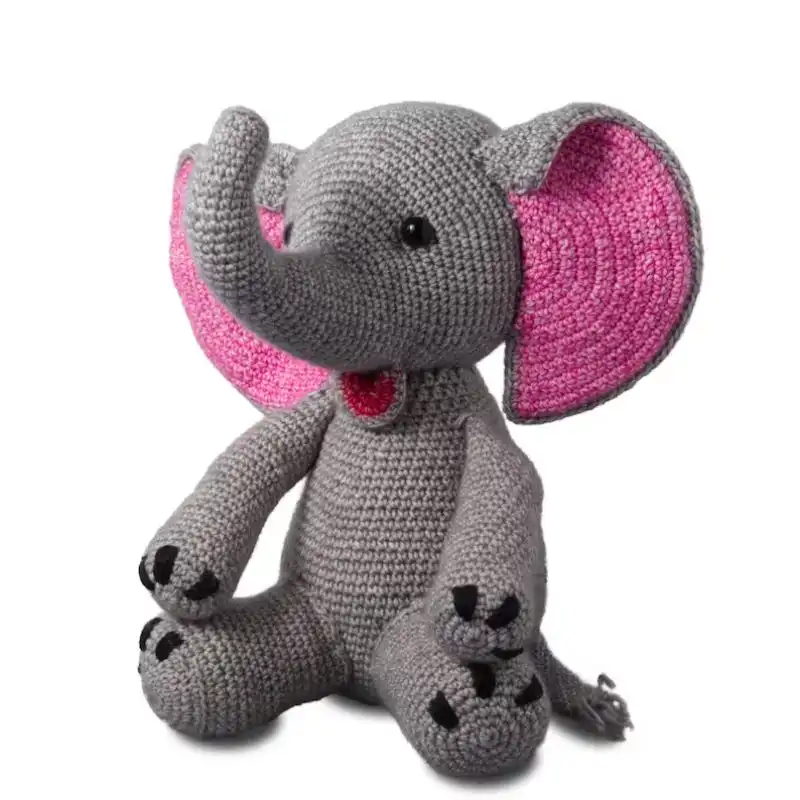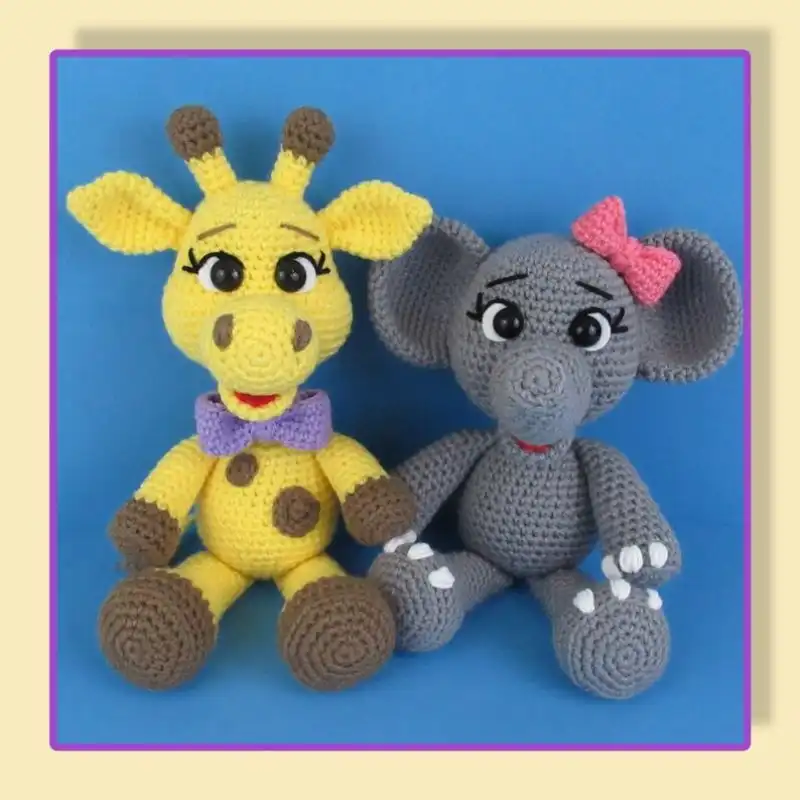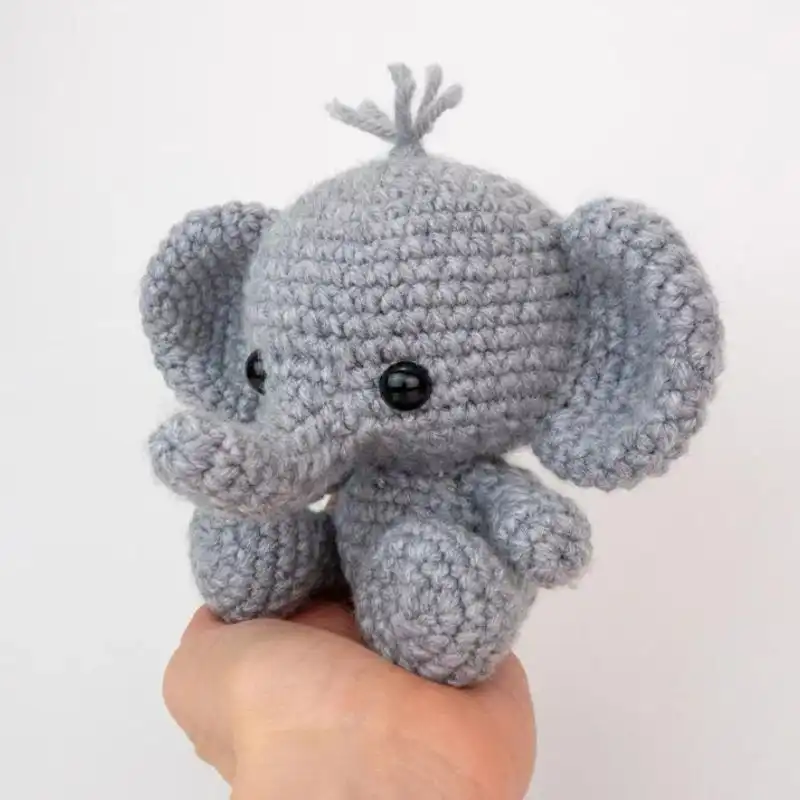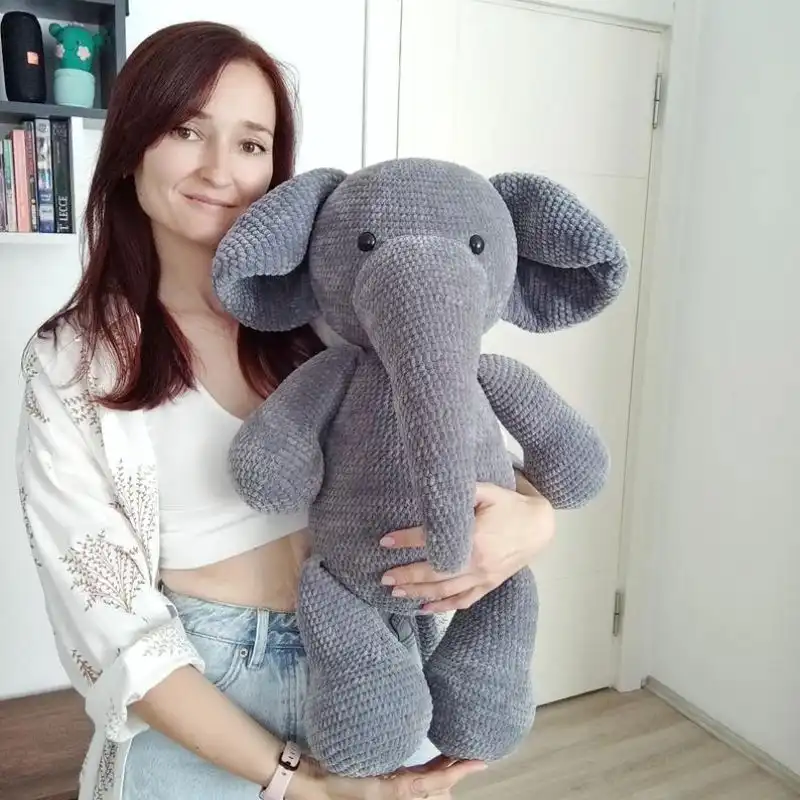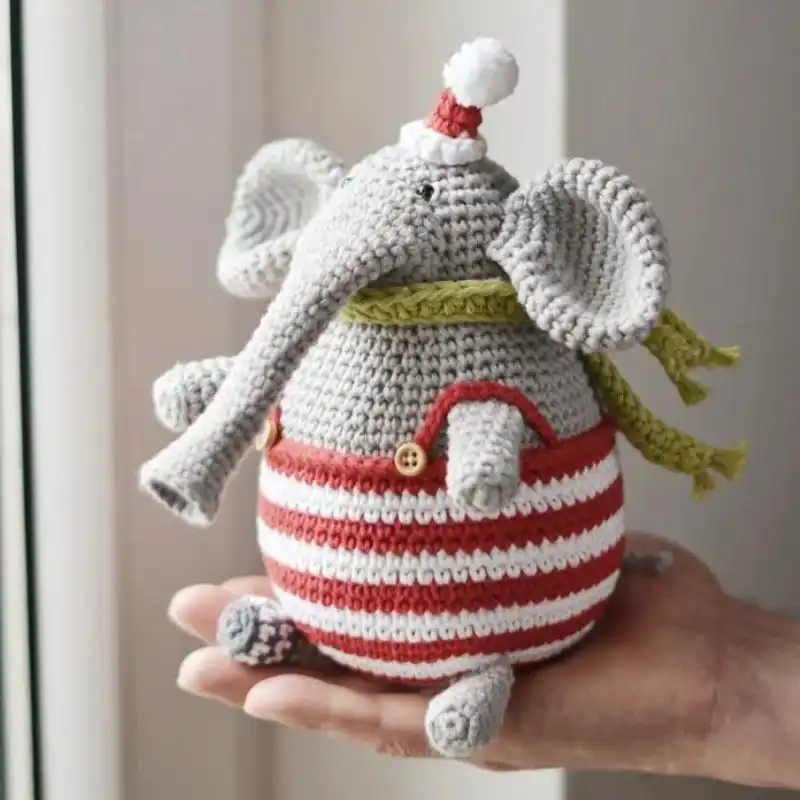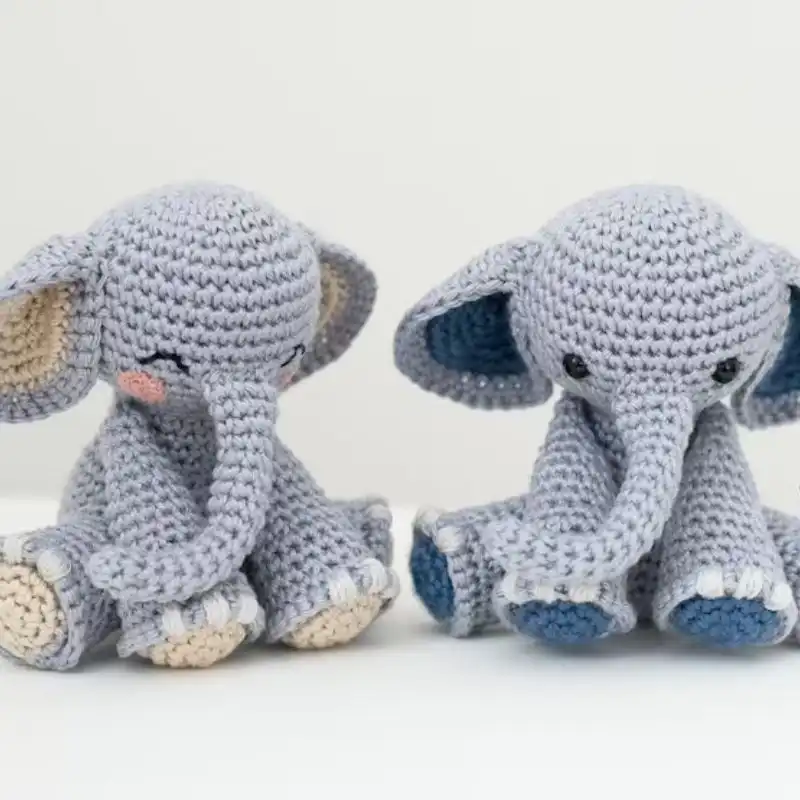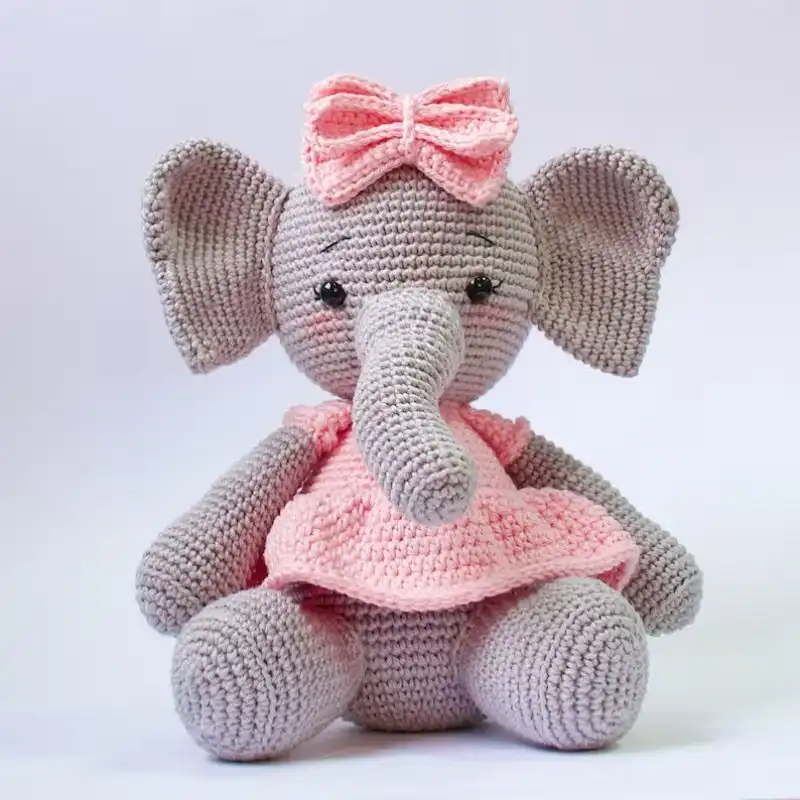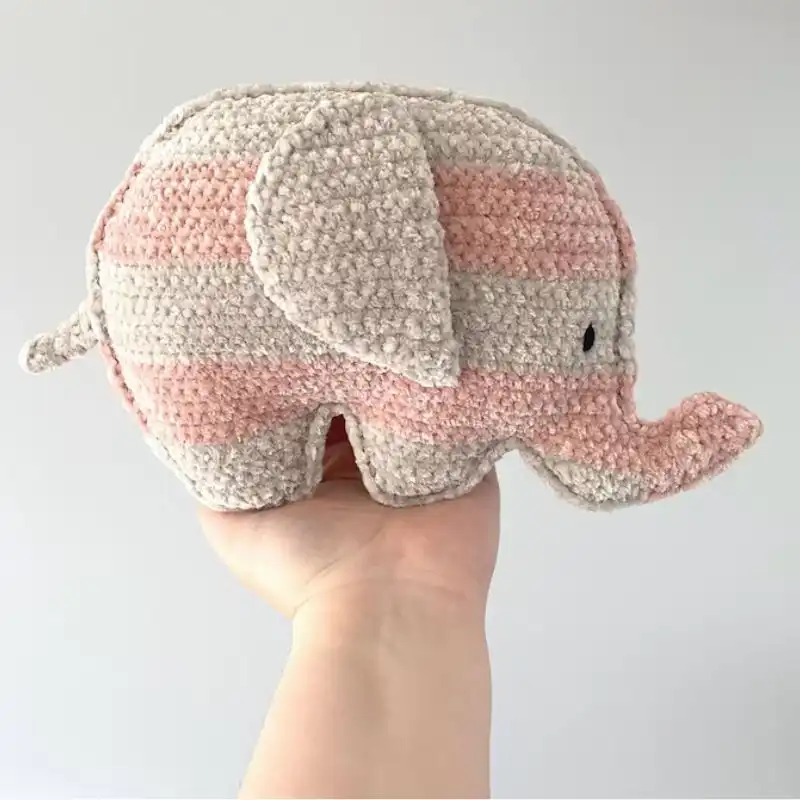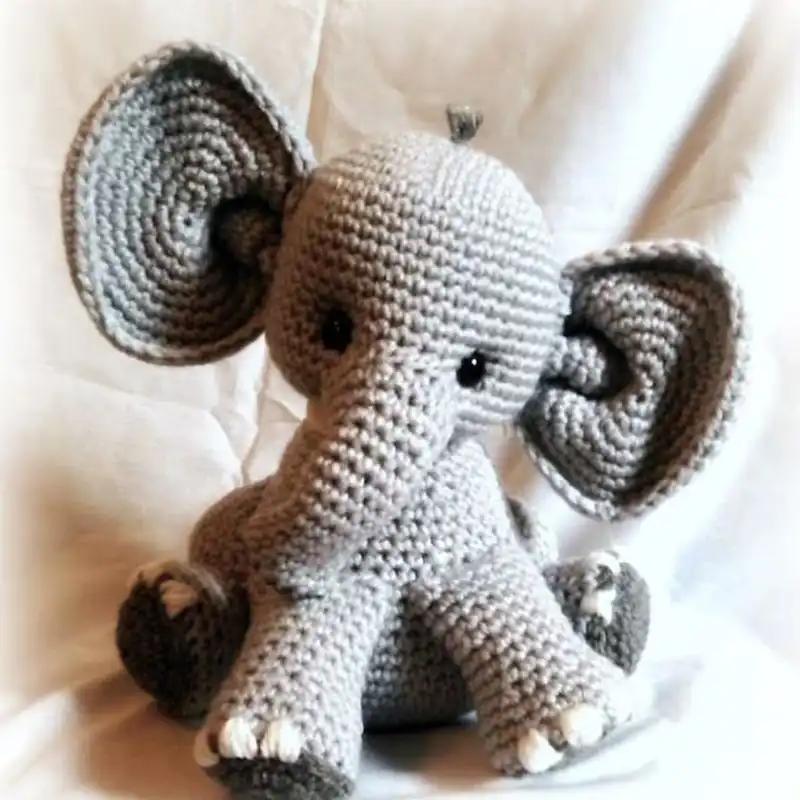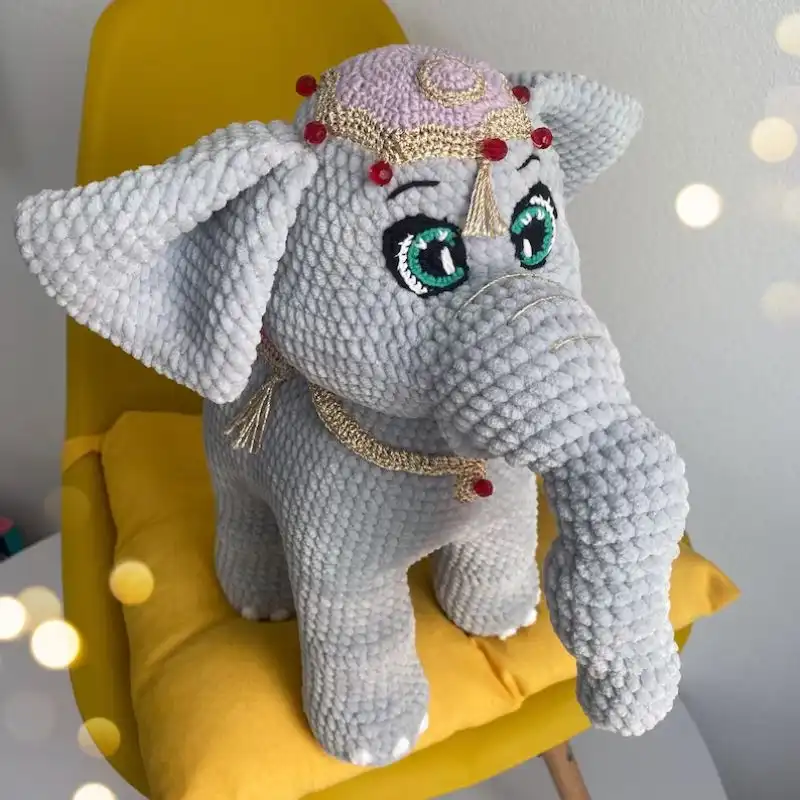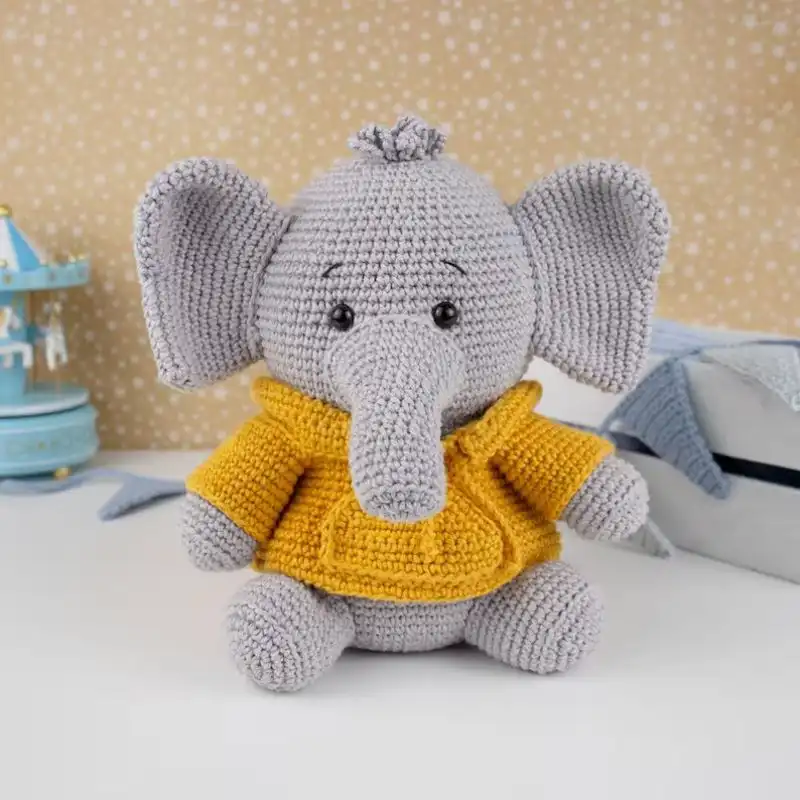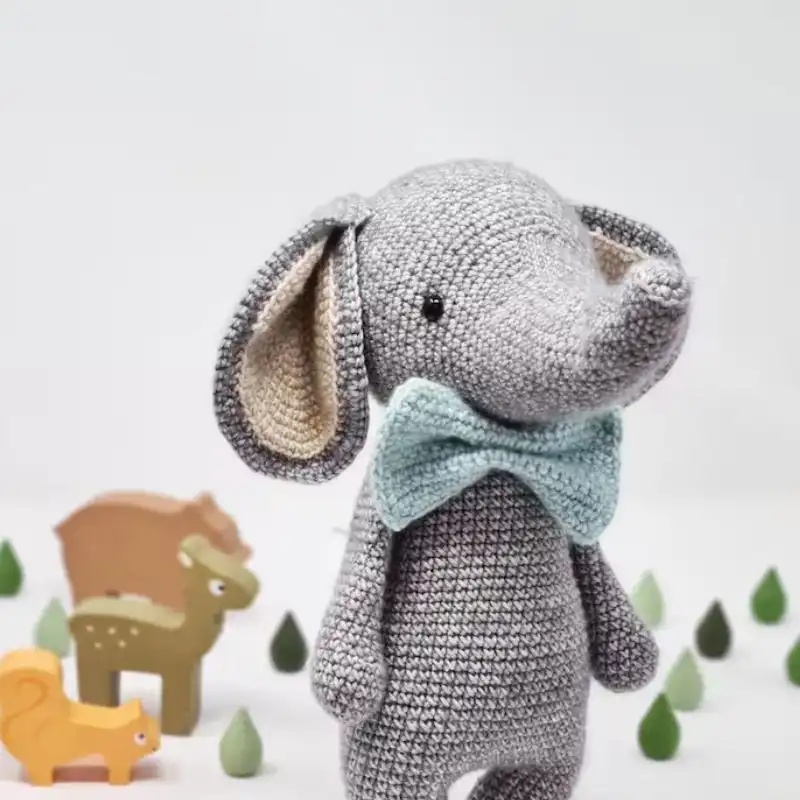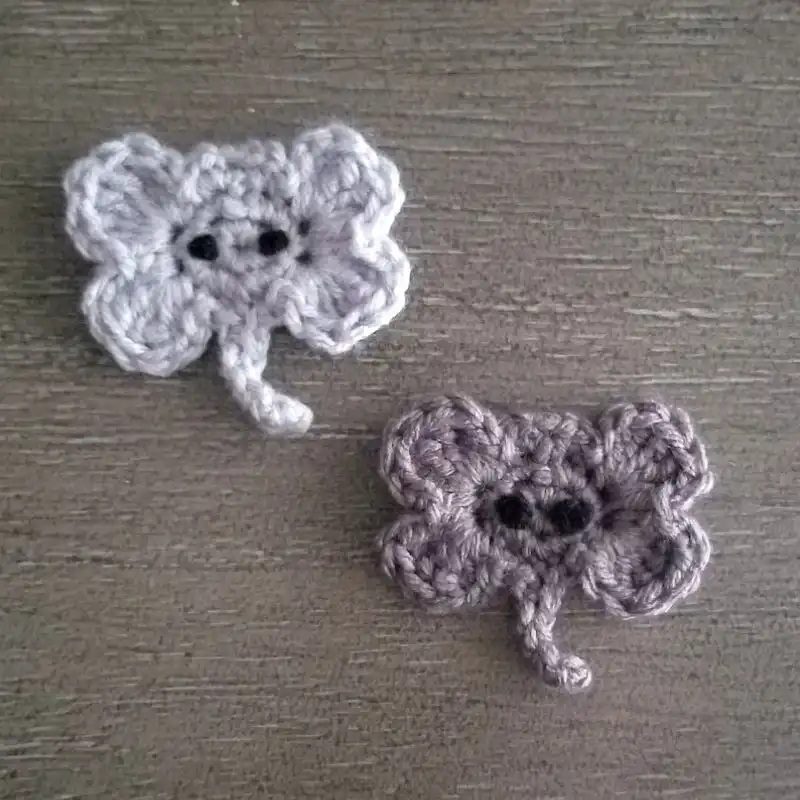Did you know that elephants are the largest land animal on Earth? And yet, fun fact, these gentle giants have the same reaction to humans that we have with puppies: they think we’re cute! Honestly, elephants are amazing animals, full of amazing traits, and majestic to look at.

If you know of someone who loves elephants, or you yourself love elephants, why not create a crochet version as a gift? Whether it’s to cuddle with, or as home decor, crochet elephants are adorable, and you can make them unique by choosing whatever colors you’d like! All you need is a pattern, with a design that you like.
And to help you out, we’ve compiled a list with 21 of our favorite elephant crochet patterns, all of them amazing designs that come with plenty of detailed instructions to guide you through the process. Let’s take a look at them!
Here are our 21 favorite elephant crochet patterns:
Is It Worth To Crochet An Elephant?
Crocheting an elephant is worth it for several reasons. Firstly, it’s a rewarding creative endeavor that allows crafters to bring a charming, whimsical creature to life through yarn and skill. The therapeutic and enjoyable process offers a sense of accomplishment upon completion.
These handmade elephants can become cherished gifts, unique home decorations, or treasured keepsakes, reflecting the time, effort, and love invested in their creation.
Additionally, they often serve as engaging projects for beginners and experienced crocheters, allowing for skill development and artistic expression. Overall, crocheting an elephant offers a blend of artistic fulfillment, emotional value, and the joy of crafting.
Various Stitches To Crochet An Elephant
Crocheting an elephant involves a variety of stitches, each contributing to the final creation’s overall shape, texture, and detail. Here are some fundamental stitches and their explanations:
- Chain Stitch (ch): This is the most basic crochet stitch, often used to start a project. It forms the foundation chain, a series of loops through which other stitches are made.
- Slip stitch (sl st): Used to join stitches together, typically at the end of a round. It’s a way to move the yarn across an area without adding height or bulk.
- Single crochet (sc): A fundamental stitch that creates a tight, dense fabric. It’s used for most of the elephant’s body, providing a solid structure ideal for stuffed toys.
- Half Double crochet (hdc): A stitch slightly taller than a single crochet. It’s often used in amigurumi for smoother transitions and shaping, especially in curved areas like the trunk.
- Double Crochet (DC): A taller stitch that adds height quickly. It can be used for more enormous elephants or specific parts like ears to give them more drape.
- Increase (inc): This involves making two stitches into the same stitch from the previous round, used for shaping and creating curves in the elephant’s body.
- Decrease (dec): Combining two stitches into one, this technique is used to taper or shape parts of the elephant, such as the end of the trunk or the legs.
- Magic Ring (also known as Magic Circle or Adjustable Ring): A technique used to start amigurumi projects. It allows you to close the hole tightly at the beginning of the round, perfect for the top of the elephant’s head or the start of limbs.
How Long Should An Elephant Be?
The size of a crocheted elephant can vary greatly depending on the pattern, yarn weight, hook size, and individual crocheter’s tension. Here’s a breakdown of how these factors influence the size:
- Pattern Specifications: Patterns for crocheted elephants come in a wide range of sizes, from tiny amigurumi just a few inches tall to giant plushies that can be over a foot in length. The pattern should specify the expected size of the finished elephant.
- Yarn Weight: The thickness of the yarn used plays a significant role in determining the size. Thicker yarns, like bulky or super bulky, will produce larger elephants, while using finer yarns, like sport or fingering weight, will result in smaller ones.
- Hook Size: The size of the crochet hook should correspond to the yarn weight, but altering it can change the size of the elephant. A larger hook with the same yarn will make a more enormous elephant, while a smaller hook will make a tighter, smaller one.
- Crocheter’s Tension: Personal crochet tension also affects size. Tighter crocheters tend to make smaller projects, whereas looser crocheters end up with larger ones.
- Miniature Elephants: These can be as small as 2-3 inches long using fine yarn and a small hook. Ideal for keychains or small decorations.
- Medium-sized Elephants: Typically made with worsted weight yarn and an appropriate hook, they can range from 5-8 inches in length.
- Large Elephants: Created with bulky yarn and a larger hook, these can be 12 inches long, suitable as cuddly toys or pillows.
- The desired use of the elephant (e.g., as a toy, decoration, or gift) can guide the choice of size. It’s important to remember that the sizes are approximate and can vary based on the factors mentioned. Refer to the pattern for specific guidance and adjust according to your needs and preferences.
Essential Tools And Materials
Glossary Of Crochet Stitches And Techniques
- Chain Stitch (ch): The primary starting point for most crochet projects, forming the foundation chain.
- Slip stitch (sl st): Used to join stitches together or to move the yarn across a surface without adding height.
- Single crochet (sc): A basic stitch creates a tight, dense fabric.
- Half Double crochet (hdc): A stitch in height between a single crochet and a double crochet.
- Double Crochet (DC): A taller stitch that creates a more open fabric than a single crochet.
- Treble Crochet (tr): A long, tall stitch that adds a lot of height with each stitch.
- Magic Ring or Circle: A technique used in amigurumi to start a project in a round, allowing the center to be tightly closed.
- Increasing (inc): Adding stitches to a row or round widens the work.
- Decreasing (dec): Combining stitches to reduce the width or to shape the work.
- Front Loop Only (FLO) and Back Loop Only (BLO): Crocheting into only one loop of the stitch instead of both, creating a ribbed or textured effect.
- Yarn Over (yo): Wrapping the yarn over the crochet hook.
- Fasten Off (fo): Cutting the yarn and pulling the tail through the last loop to secure the end of a project.
- Gauge: The number of stitches and rows per inch affects the size of the finished project.
- Blocking: The process of wetting and shaping a finished crochet piece to its final dimensions and letting it dry.
- Cluster Stitch: A group of stitches worked together in the same space, often used for decorative effects.
- Bobble Stitch: A textured stitch that creates a raised ‘bubble’ on the fabric.
- Popcorn Stitch: Similar to a bobble, but with a slightly different technique, creating a pop-out effect.
- Shell Stitch: A series of stitches worked into the same stitch to create a shell-like design.
- Picot: A small loop often used as an edging or decorative element.
- Work in the Round: Crocheting in a continuous spiral, often used in amigurumi and hats.
- Work in Rows: Crocheting back and forth in lines, turning the work at the end of each row.
RELATED: 41 Free Quick And Easy Crochet Borders [2 Rows Only]
Understand Crochet Stitches & Techniques
As an experienced crocheter, I’ve learned that understanding crochet stitches and techniques starts with familiarizing yourself with the basic terms and symbols in patterns. Practicing each stitch, like single, double, and treble crochet, is crucial to recognizing their appearance and texture.
I also recommend learning to read both written instructions and crochet diagrams, as they offer different perspectives on the same pattern.
Paying attention to yarn weight and hook size is vital since they directly impact your stitch size and tension. Patience and practice are essential; the more you crochet, the more intuitive these stitches and techniques become.
Which Yarn Is Best To Crochet An Elephant?
As someone who loves crocheting amigurumi, especially elephants, I’ve experimented with various yarns to find what works best. Here are my insights:
- Cotton Yarn: My top choice for amigurumi elephants. It’s sturdy, holds shape well, and gives a clean, defined stitch appearance. Ideal for toys that might get a lot of handling.
- Acrylic Yarn: A great alternative to cotton. It’s widely available, affordable, and comes in various colors. Acrylic is also durable and easy to wash, making it a practical choice for children’s toys.
- Wool Yarn: Wool can be lovely for a softer, cuddlier elephant. It’s warm and has a nice texture, but it can be more challenging to care for due to felting risks. I recommend superwash wool for easier maintenance.
- Blend Yarns: Blends of cotton-acrylic or wool-acrylic can offer the best of both worlds. They maintain shape while providing softness and are generally easy to work with.
- Chunky Yarns: For a larger, squishier elephant, chunky yarns can be fun to work with. They make the crocheting process quicker, resulting in a bigger finished product, perfect for a plush toy or pillow.
- Velvet or Chenille Yarns are great for a unique, soft texture. They create a plush, velvety elephant but can be tricky due to their slippery nature.
How Much Yarn Do I Need To Crochet An Elephant?
As a seasoned crocheter, I’ve learned that the yarn needed to crochet an elephant can vary based on several factors. Typically, for a standard-sized amigurumi elephant (about 6 to 8 inches tall), I use around 100 to 150 yards of medium-weight yarn (like worsted or aran).
However, this can change depending on the yarn’s thickness, the crochet hook size, and the tightness of my stitches.I might need a bit more if I’m using a finer yarn, like sport or DK weight, whereas with a bulky yarn, I’d use less.
Also, I account for additional yarn if the pattern includes extra details like a larger trunk or prominent ears.I always recommend buying more yarn than you think you’ll need.
Running out partway through is frustrating, especially if the yarn color is hard to match later. Plus, leftover yarn can be used for small accents or other projects.
Is It Beginner Friendly?
From my experience, crocheting an elephant can be beginner-friendly, especially if you choose a simple pattern. With their basic shapes and minimal complex features, elephants make them a great starting point for newcomers to amigurumi.
As a beginner, you’ll primarily use basic stitches like single crochet and simple increases and decreases for shaping. It’s a gratifying project that helps build confidence in following patterns and shaping techniques.
While some finer details might require more patience, an elephant is a manageable and enjoyable project for those just starting their crochet journey. Plus, the result is gratifying!
How To Crochet A Beginner-Friendly Elephant?
Skill Level: Beginner
Materials
- Medium-weight yarn (e.g., Worsted or Aran) in your chosen color(s)
- Crochet hook (size appropriate for your yarn, usually 3.5mm to 4.5mm)
- Polyester fiberfill for stuffing
- Yarn needle
- Stitch markers
- Safety eyes (optional; can use yarn to embroider eyes instead)
- Scissors
Basic Stitches to Know
- Chain (ch)
- Slip stitch (sl st)
- Single crochet (sc)
- Increase (inc)
- Decrease (dec)
Instructions
Head and body (worked as one piece)
- Start with a magic ring.
- Round 1: 6 sc in magic ring.
- Round 2: Inc in each stitch around (12 sc).
- Round 3: [Sc in next stitch, inc in next stitch] around (18 sc).
- Continue increasing in this pattern until you reach the desired head size.
- Work a few rounds without increasing to form the head.
- Begin decreasing in the same pattern to form the upper body, stuffing firmly.
- Continue until the body is entirely shaped and closed.
Ears (make 2)
- Start with a magic ring.
- Round 1: 6 sc in magic ring.
- Round 2: Inc in each stitch around (12 sc).
- Flatten the ear and use a yarn needle to attach them to the head.
Legs (make 4)
- Start with a magic ring.
- Round 1: 6 sc in magic ring.
- Round 2: Inc in each stitch around (12 sc).
- Work a few rounds without increasing.
- Stuff lightly and sew them to the body.
Trunk
- Start with a magic ring.
- Work several rounds of sc, increasing as necessary to get a slight curve.
- Stuff lightly and attach to the face.
Tail
- Chain to the desired length and add a small tassel at the end.
- Sew it to the back of the body.
Assembly
- Sew on the body’s ears, legs, trunk, and tail.
- Attach the safety eyes or embroider the eyes with yarn.
Finishing Touches
- Weave in any loose ends with your yarn needle.
- Optionally, add a bow or other decorations.
21 Crochet Elephant Patterns
1.Yarn Zoo Store Crochet Elephant Pattern
First, this adorable crochet pattern by the Yarn Zoo Store allows you to create Fred the Elephant. He’s perfect as a cuddly toy and once finished, he should stand almost 10 inches tall!
2.Giraffe And Elephant Crochet Pattern
Embark on a delightful crochet journey with the Giraffe and Elephant Crochet Pattern. This pattern combines two charming creatures, the elegant giraffe and the lovable elephant, creating a whimsical and adorable duo perfect for cuddles and play.
Suggested Yarn: Cotton Blend Yarn
Difficulty Level: Intermediate
Yarn Weight: DK
Crochet Hook Size: 4mm
3.Mommy And Baby Funny Plush Elephants
Celebrate the bond between mother and child with the Mommy and Baby Funny Plush Elephants crochet pattern. This heartwarming design captures the joy and playfulness of a baby elephant with its protective and endearing mother, making it an ideal project for creating a precious keepsake.
Suggested Yarn: Chenille Yarn
Difficulty Level: Intermediate
Yarn Weight: Bulky
Crochet Hook Size: 6mm
4.ChiquiPork Bubba The Elephant Crochet Pattern
Another adorable elephant crochet pattern we recommend you check out is Bubba, the crochet elephant by ChiquiPork. The result is a seated elephant measuring almost 8 inches.
Suggested Yarn: Velvet Yarn
Difficulty Level: Advanced
Yarn Weight: Super Bulky
Crochet Hook Size: 8mm
5.Theresa’s Crochet Shop Ellis The Elephant Crochet Pattern
If you’re looking for a crochet pattern that allows you to create a tiny baby elephant, easy to make with scrap yarn in just a few hours, then this Ellis the Elephant by Theresa’s Crochet Shop is the one for you.
6.Big Grey Elephant Pillow
Enrich your living space with the Big Grey Elephant Pillow. This oversized and huggable crochet creation is not just a pillow but a charming decor piece. The big grey elephant adds a touch of whimsy and comfort to any room, making it a unique and cozy addition to your home.
7.Christmas Elephant Crochet Pattern
Infuse the holiday spirit with the Christmas Elephant Crochet Pattern. Dressed in festive attire, this crochet elephant is ready to spread joy and merriment. Whether used as a decoration or a special gift, this pattern brings a touch of Christmas magic to your crafting endeavors.
Suggested Yarn: Acrylic Yarn
Difficulty Level: Intermediate
Yarn Weight: Worsted
Crochet Hook Size: 5mm
8.Everly the Elephant Crochet Pattern
This pattern by HH Designs4 will allow you to crochet your Everly elephant with enormous ears and a pretty flower crown, perfect as home decor or as a cuddly toy.
9.Joe The Elephant Crochet Pattern
Yarn Wave Shop has this fantastic crochet pattern to help you create Joe the Elephant. It is cute, soft, and easy to customize depending on the colors you use so that you can make it your own.
Suggested Yarn: Cotton Blend Yarn
Difficulty Level: Intermediate
Yarn Weight: Worsted
Crochet Hook Size: 5mm
10.Pretty Elephant Crochet Pattern
If you want to give a child an adorable crochet elephant, complete with a bow and dress, then you must try out this Gatofiotelie pattern. The finished result should be almost 8 inches, although this depends on the yarn you use.
Suggested Yarn: Alpaca Blend
Difficulty Level: Advanced
Yarn Weight: Fingering
Crochet Hook Size: 3.25mm
11.Small Elephant Crochet Pattern
This Brilliant Crochet Small Elephant Crochet Pattern will allow you to create your tiny elephant, adorable and soft, at less than 3 inches tall. It’s ideal for using up any scrap yarn you have.
12.Chubby Elephant Crochet Pattern
Embrace the cuteness overload with the Chubby Elephant Crochet Pattern. This design features a plump and adorable elephant, making it the perfect project for those who appreciate the charm of chubby, roly-poly creatures. Create a lovable friend that’s impossible to resist.
13.Elephant Trophy Head Crochet Pattern
Do you know how some people decorate the house with animal head trophies, but it’s a little macabre? Why not create an alternative: a super cute crochet elephant trophy head? Perfect for home decor!
Suggested Yarn: Faux Fur Yarn
Difficulty Level: Advanced
Yarn Weight: Super Bulky
Crochet Hook Size: 10mm
14.Percy The Baby Elephant Crochet Pattern
Another adorable tiny crochet elephant option, perfect for cuddling, is the one you can create with the help of the Mostly Stitching Percy, the baby elephant crochet pattern.
15.Cute Funny Elephant Crochet Pattern
Dive into the world of whimsy with the Cute Funny Elephant Crochet Pattern. This playful design captures the essence of humor and charm, making it a delightful project for crocheters of all skill levels. Create a funny elephant friend that brings smiles and laughter.
Suggested Yarn: Cotton Blend Yarn
Difficulty Level: Beginner
Yarn Weight: Medium (4)
Crochet Hook Size: 5mm
16.Mother And Baby Elephant Crochet Pattern
This crochet pattern by Lau Loves Crochet will allow you to create a beautiful crochet elephant and a matching baby! Plus, you can store the baby in a hidden pocket on the mother elephant!
17.Alexandra Simba Elephant Crochet Pattern
If you want to make a more elaborate and ornamental crochet elephant that can be decorated on the mantelpiece, look at this option by Crochet Pattern Guru.
Suggested Yarn: Alpaca Blend
Difficulty Level: Intermediate
Yarn Weight: Worsted
Crochet Hook Size: 5mm
18.Elephant with Sweater Crochet Pattern
Cozy up with the Elephant with Sweater Crochet Pattern. This adorable creation features a sweet elephant adorned in a snug sweater, adding a touch of warmth and style to your crochet projects. Perfect for gifting or as a charming decor piece, this pattern combines comfort and cuteness in one delightful package.
19.Mir Elephant Crochet Pattern
This crochet pattern by PinkTomatoCrochet will allow you to create Mir, the elephant. Standing upright and wearing a bowtie, he is a proper gentleman and super cuddly.
20.Elephant Applique Crochet Pattern
If you want something simple and fast that can be done using scrap yarn, then why not follow the HCK Crafts crochet pattern to create some elephant appliques? They can then be attached to clothing and bags or used any way you want!
Suggested Yarn: Cotton Blend Yarn
Difficulty Level: Beginner
Yarn Weight: Sport
Crochet Hook Size: 3.5mm
21.Dumbo Elephant Crochet Pattern
Last but certainly not least, we have this Dumbo elephant crochet pattern by BestGift4You, because we can’t talk about elephants and not include this Disney icon.
Wearing his iconic circus outfit, he is almost 8 inches in size.
Suggested Yarn: Chenille Yarn
Difficulty Level: Intermediate
Yarn Weight: Bulky
Crochet Hook Size: 6.5mm
Do’s & Don’ts To Crochet A Safe Elephant
Do’s
- Use Safe Materials: Always choose non-toxic, hypoallergenic yarns and stuffing, primarily if the elephant is intended for young children.
- Secure Attachments: Ensure all parts, like ears, limbs, and eyes, are securely attached. If using safety eyes, make sure they are correctly fastened. Embroider eyes with yarn instead of plastic eyes for infants or young children.
- Tight Stitches: Work with tight, even stitches to prevent stuffing from coming out and to ensure the toy’s durability.
- Washable Yarn: If possible, use machine-washable yarn for easy cleaning, as toys can get dirty quickly.
- Test for Choking Hazards: Regularly check the toy for loose parts or unraveling, which can pose choking hazards.
- Soft Stuffing: Use a safe, soft polyester fiberfill that won’t clump over time.
- Read and Follow the Pattern Carefully: Especially if you’re a beginner, sticking to the pattern helps ensure the toy is crafted correctly and safely.
Don’ts
- Avoid Small, Loose Parts: For children under three, avoid adding small parts like buttons or beads that can be choking hazards.
- Don’t Over-Stuff: Over-stuffing can make the toy too firm for cuddling and may stress the stitches, leading to potential holes.
- Avoid Using Wire for Shaping: Wires can poke through the yarn and harm a child. If you need to shape parts of the elephant, do it with stitching or soft materials.
- Don’t Ignore Gauge: While it might not seem crucial for a toy, the wrong gauge can affect the size of the holes between stitches, potentially making it unsafe.
- Avoid Harsh Chemicals: When cleaning the toy, use gentle, child-safe detergents and avoid harsh chemicals.
- Don’t Use Heavy Yarn: Heavy or rough yarn can make the toy less cuddly and potentially irritating to sensitive skin.
Tips & Tricks To Avoid Crochet Mistakes
Crocheting a perfect elephant requires attention to detail and some practiced techniques. Here are various tips and tricks to help avoid common mistakes:
How To Block The Crochet Elephant?
Blocking is a crucial finishing step in crocheting, especially for amigurumi like an elephant, as it helps to shape and set your project. Here’s how to block your crochet elephant:
Materials Needed
- Blocking board or foam mat
- Rust-proof pins
- Spray the bottle with water or a blocking solution.
- Towel (optional)
Instructions
Complete the Crochet: Finish all crocheting, weaving in ends, and assembling your elephant.
Prepare Blocking Surface: Lay out your blocking board or foam mat. If you don’t have these, you can use any flat, water-resistant surface like a large towel.
Position the Elephant: Gently lay your crocheted elephant on the blocking surface. Shape it as desired, paying particular attention to areas like the trunk, ears, and legs to ensure they are in the correct position and alignment.
Pin in Place: Secure the elephant to the blocking surface using rust-proof pins. Pinning helps maintain the desired shape as it dries. Be careful not to stretch the fabric too much, just enough to shape it properly.
Moisten the Elephant: Use a spray bottle to mist the elephant lightly with water or a blocking solution. The piece should be damp but not soaking wet. For heavier yarns, you might need to spray a bit more.
Let It Dry: Allow the elephant to air dry completely. Depending on the yarn and the project’s thickness, it can take anywhere from several hours to a full day.
Remove Pins: Carefully remove the pins once the elephant is completely dry.
Final Shaping: If needed, do some final hand shaping to tweak any areas that need it.
Assess and Repeat if Necessary: Sometimes, a second round of blocking might be necessary to achieve the perfect shape, especially for larger or more complex pieces.
RELATED: How To Make Crossed Stitch In Crochet With Tips For Flawless Handiwork?
Suggestions To Add Style & Personal Touch
Adding style and personal touches to your crochet elephant can transform it into a unique, cherished creation. Here are various suggestions to enhance its charm and character:
- Color Choices: Experiment with different yarn colors. Consider multicolored or ombre yarns for a unique effect, or stick to classic grey tones for a more traditional look.
- Textured Yarns: Use textured yarns like bouclé, chenille, or eyelash yarn for parts of the elephant, like the ears or tail, to add an interesting tactile element.
- Embellishments: Sew on small embellishments like ribbons, bows, buttons (be cautious with young children), or beads to add a bit of flair.
- Embroidery Details: Add embroidered details such as a smile, eyelashes, or a decorative pattern on the ears or body.
- Custom Accessories: Crochet accessories like a hat, scarf, or blanket to drape over the elephant’s back. It not only adds color but also a personal touch.
- Contrasting Ears: Use a contrasting color for the inner ears to give a pop of color and highlight the ears.
- Floral Additions: Attach small crochet flowers or leaves around the ears or on the body to create a whimsical, garden-themed elephant.
- Personalized Tags or Labels: Add a personalized tag or label with a message, name, or date, especially if the elephant is a gift.
- Felt Accents: Use felt to add details like cheeks or footpads. Felt can give a clean, defined look to these features.
- Varied Textures: Incorporate different stitches in areas like the blanket or saddle to introduce texture contrasts.
- Interactive Elements: Consider adding elements like a small pocket or a rattle inside for children’s toys.
- Change the Size: Alter the size of your elephant by using thicker yarn and a larger hook for a bigger toy or thinner yarn and a smaller hook for a tiny version.
- Theme it: Match the elephant to a theme, like a circus elephant with a colorful headdress and collar or a safari elephant with a rugged, natural look.
- Fringe or Tassels: Add fringe or tassels to the end of the tail for a fun, playful element.
Wash & Care Instructions
Proper care and washing of your crochet elephant are essential for its longevity and durability. Here are the wash and care instructions:
Check Yarn Labels: Always check the care instructions on the yarn label used to crochet the elephant before washing. Different yarns may have specific care requirements.
Hand Wash Preferred: Hand wash the elephant in lukewarm water using a mild detergent. Avoid using bleach or harsh chemicals. Submerge the toy, lightly squeeze the suds through it, then rinse until the water clears.
Spot Cleaning: For minor soiling, spot cleaning with a damp cloth and mild detergent is usually sufficient. Gently pat the stained area; avoid rubbing, as this can damage the fibers.
Avoid Twisting or Wringing: Don’t twist or wring the elephant; it can distort its shape and loosen the stitches. Instead, gently press out the excess water.
Drying:
- Lay the elephant flat on a clean, dry towel.
- Reshape it while it’s damp, paying attention to the ears, trunk, and legs.
- Let it air dry thoroughly before use.
- Avoid using a tumble dryer, as the heat can damage the yarn and stuffing.
Avoid Direct Sunlight: When drying, avoid placing the elephant in direct sunlight, which can cause colors to fade.
Fluff and Reshape: Once dry, fluff up the stuffing from the outside to bring back its shape and softness.
Storing: Store the elephant in a cool, dry place. Avoid storing in plastic bags for long periods, leading to moisture build-up and mildew. A cotton bag or a box is preferable.
Regular Dusting: Regularly dust the elephant with a soft brush to keep it clean and fresh.
Repairing Damages: If the elephant becomes damaged, repair it promptly to prevent further unraveling or tearing.

A Quick Recap
This article explored the delightful world of crocheting elephants, covering everything from choosing the suitable yarn and size to detailed instructions for beginners. We discussed the essential tools and materials needed, along with a comprehensive glossary of crochet stitches and techniques. Safety tips and suggestions for adding personal style were highlighted to ensure your crocheted elephant is charming and unique. Finally, we provided essential wash and care instructions to maintain the longevity and durability of your creation.
Frequently Asked Questions
How Do You Crochet An Easy Elephant?
To crochet an elephant easily, you should get an easy crochet pattern suitable for beginners and those with minimal experience. Then, all you have to do is follow the detailed instructions and go step by step until you finish your elephant!
How Do You Crochet An Elephant Tail?
You can crochet an elephant’s tail by creating a small, thin line and attaching it to the main elephant’s body. Alternatively, simply follow an easy crochet pattern, which will tell you exactly how to make the tail, along with the rest of the elephant!
Are Elephants Easy To Crochet?
Elephants are not the easiest animals to crochet, but they are relatively simple once you break them down into shapes and parts! It also depends on the design of the elephant, as some can be a lot simpler than others.
What Skill Level Is Required To Crochet An Elephant?
Crocheting an elephant can range from beginner to intermediate levels, depending on the pattern complexity. Basic patterns require knowledge of fundamental stitches like single crochet, increases, and decreases.
Can I Use Any Type Of Yarn To Crochet An Elephant?
While you can use various yarn types, cotton or acrylic yarns are often preferred for their durability and ease of care, primarily if the elephant is intended for children.
How Long Does It Take To Crochet An Elephant?
The time it takes can vary widely depending on your skill level and the complexity of the pattern. A simple elephant might take a few hours, while a more detailed one could take several days.
Do I Need Special Tools To Crochet An Elephant?
You might need stuffing, safety eyes, and stitch markers besides standard crochet tools like a hook, yarn, and a yarn needle. These help in giving your elephant the right shape and features.
- 30 Polo Sweater Knitting Patterns To Keep You Stylish On Every Occasion - January 1, 2024
- 21 Baby Blanket Knitting Kits To Wrap Bundle Of Joy With Love - January 1, 2024
- 15 Cashmere Knitting Kits For Fashionable Knits To Embrace Comfort And Style - January 1, 2024


